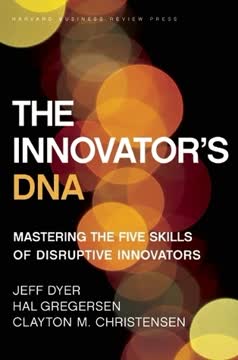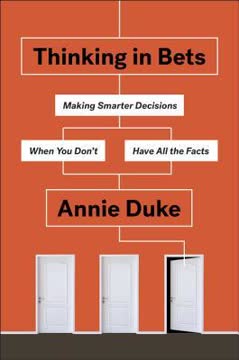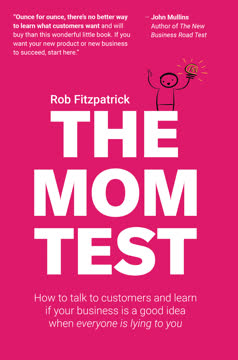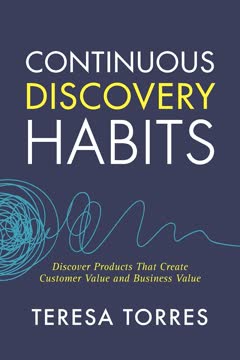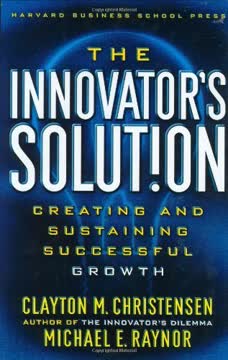つの重要なポイント
1. ジョブ理論:顧客は特定の状況で進歩を遂げるために製品を「雇う」
「ジョブ」とは、特定の状況で人が達成しようとしている進歩のことを指す。
製品ではなく進歩。 ジョブ理論は、顧客が単に製品やサービスを購入するのではなく、それらを生活に取り入れて進歩を遂げると主張する。この進歩は、ジョブの機能的、社会的、感情的な側面によって定義される。この理論は、顧客の選択の背後にある因果メカニズムを理解するための枠組みを提供し、より予測可能なイノベーションアプローチを提供する。
状況が重要。 ジョブは、それが発生する特定の状況の文脈でのみ完全に理解される。これらの状況には、機能的な状況だけでなく、社会的および文化的な圧力、ライフステージの要因、経済的な状況も含まれる。ジョブに焦点を当てることで、企業は従来の顧客セグメントや製品カテゴリを超えて、新しいイノベーションの機会を見つけることができる。
- ジョブの主要要素:
- 望まれる進歩
- 特定の状況
- 機能的、社会的、感情的な側面
- 競合する解決策
- 障害と不安
2. ジョブを見つけるには顧客の苦労を深く理解する必要がある
顧客が言えないことを聞くには、初心者の心を保ちながら、顧客との慎重な観察と対話が必要である。
苦労を探す。 ジョブを見つけるためには、イノベーターは探偵とドキュメンタリーフィルムメーカーの役割を果たす必要がある。顧客が苦労している瞬間を観察し、回避策や補償行動、既存の解決策が不足している場面を探す必要がある。これには先入観を捨て、初心者の心を保つことが求められる。
顧客のストーリーを作る。 効果的なアプローチの一つは、顧客の経験の詳細なストーリーボードを作成し、彼らの苦労と進歩を完全に捉えることである。これらのストーリーには、新しい解決策を求める「プッシュ」要因と、新しい提供物の「プル」要因、そして変化を妨げる不安や習慣の力が含まれるべきである。
- ジョブを見つける方法:
- 自然な環境での顧客の観察
- 特定の状況に焦点を当てた詳細なインタビュー
- 既存製品の予期しない使用法の調査
- 非消費と回避策の研究
- 詳細な顧客ジャーニーマップの作成
3. イノベーションの成功は製品の改善ではなくジョブの達成にある
新製品が成功するのは、その機能や特徴ではなく、提供する体験による。
ジョブ全体を解決する。 成功するイノベーションは、既存製品の漸進的な改善を提供するだけではない。顧客が達成しようとしているジョブのすべての側面、つまり機能的、感情的、社会的な側面を含む包括的な解決策を提供する。これには、従来の製品の枠を超えて、まったく新しいカテゴリやビジネスモデルを作成することが求められることが多い。
障害を取り除く。 ジョブを達成するための重要な部分は、顧客が進歩を遂げるのを妨げる障害を特定し、取り除くことである。これには、複雑なプロセスの簡素化、採用に対する不安の軽減、新しい流通チャネルの作成が含まれることがある。ジョブに焦点を当てることで、企業は競合他社が見落としている分野でイノベーションの機会を見つけることができる。
- ジョブに焦点を当てたイノベーションの例:
- Airbnb:単なる宿泊施設ではなく、本物の地元体験を提供
- Uber:単なるタクシー乗車ではなく、都市の移動手段を提供
- IKEA:単なる家具販売ではなく、手頃な価格の家庭用品を提供
4. ジョブに焦点を当てることで企業のビジネスと競争の定義が変わる
この概念を理解すると、消費者のジョブを見つけるというアイデアが直感的に理解できる。
ビジネスを再定義する。 ジョブ理論は、企業に従来の業界や製品カテゴリの定義を超えて考えることを求める。企業は「ミルクシェイクビジネス」や「新聞ビジネス」に従事しているのではなく、顧客のジョブを解決することに従事していると定義すべきである。この視点の変化は、成長とイノベーションの新しい機会を開くことができる。
競争の範囲を広げる。 ジョブを理解することで、企業は競争の見方も変わる。直接の製品競合だけでなく、顧客がジョブを解決するためのすべての方法、包括的な「非消費」オプションも考慮する必要がある。この広い視点は、新しい脅威と差別化の新しい機会の両方を明らかにすることができる。
- 再定義されたビジネスの例:
- OnStar:車の機能から運転中の安心感へ
- American Girl:人形から母娘の絆を深めるための手段へ
- Southern New Hampshire University:従来の教育から働く大人のキャリア向上を支援するための手段へ
5. 顧客のジョブを解決するためには適切な体験を作ることが重要
ジョブの完全な解決策には、コア製品やサービスだけでなく、顧客が解決策を「雇い」、他の解決策を「解雇」する際に直面する障害を克服するための慎重に設計された購入と使用の体験も含まれる。
ジョブ全体を設計する。 顧客のジョブを真に解決するためには、企業は製品やサービスを取り巻く全体の体験を考慮する必要がある。これには、顧客が提供物を発見し、購入し、使用する方法、およびそれが彼らの生活にどのように統合されるかが含まれる。目標は、ジョブのすべての側面に対応するシームレスな体験を作り出すことである。
採用障壁を克服する。 体験を設計する上で重要な部分は、新しい解決策の採用を妨げる不安や習慣を特定し、対処することである。これには、リスクフリーの試用を提供したり、教育やサポートを提供したり、既存の解決策からの移行をできるだけスムーズにする方法を見つけることが含まれる。
- ジョブに焦点を当てた体験の主要要素:
- シームレスな発見と購入プロセス
- 直感的なオンボーディングと初回使用
- 継続的なサポートとエンゲージメント
- 既存の習慣やシステムとの統合
- ジョブ関連の利益の明確なコミュニケーション
6. ジョブに合わせたプロセスは持続可能な競争優位を提供する
競争優位は、顧客のジョブを実行するために機能間で統合される組織の独自のプロセスによってもたらされる。
ジョブに合わせて統合する。 顧客のジョブを一貫して提供するためには、企業は内部プロセスと組織構造をそのジョブに合わせて調整する必要がある。これには、従来の機能的なサイロを打破し、特定のジョブや顧客ジャーニーに焦点を当てた新しいクロスファンクショナルチームを作成することが求められることが多い。
独自の能力を構築する。 ジョブに合わせたプロセスは、競合他社が模倣しにくい強力な競争優位の源泉を生み出すことができる。製品はしばしば逆エンジニアリングされることがあるが、ジョブを一貫して達成するために必要な複雑なプロセスと組織能力の網は模倣が難しい。
- ジョブに合わせたプロセスの例:
- メイヨークリニック:患者のニーズに合わせた専門家の調整
- アマゾン:迅速な配送と豊富な品揃えのためのすべてのプロセスの最適化
- IKEA:手頃な価格の家庭用品を可能にするためのデザイン、製造、販売の統合
7. ジョブに焦点を当てることで分散型の意思決定と従業員のやる気を引き出す
明確に定義されたジョブは、「指揮官の意図」のような役割を果たし、従業員がすべてのレベルで顧客のジョブを達成するためのプロセスにどのように貢献するかを理解し、動機付けられるため、細かい管理の必要がなくなる。
従業員をエンパワーする。 組織のすべての人が顧客が彼らに求めているジョブを理解していると、分散型の意思決定が容易になる。従業員はすべてのレベルでジョブを指針として使用し、顧客のニーズに合わせて日々の選択を優先し、調整することができる。
意味と動機を作り出す。 ジョブに明確に焦点を当てることは、従業員にとって非常に刺激的である。これは、単に売上目標を達成することや製品の特徴を改善することを超えて、顧客のニーズに対する目的意識とつながりを提供する。この共有された使命は、多様なチームや機能を共通の目標に向けて団結させるのに役立つ。
- ジョブに焦点を当てた組織の利点:
- すべてのレベルでの明確な意思決定基準
- 改善されたクロスファンクショナルなコラボレーション
- 高い従業員エンゲージメントと動機付け
- より顧客中心の文化
- より迅速でアジャイルなイノベーションプロセス
8. ジョブから逸脱させる可能性のある一般的なデータの誤謬に注意
データは、私たちが支持したい視点を支持するように自分自身を調整する厄介な方法を持っている。
アクティブデータを超えて見る。 企業はしばしば、販売数や顧客の人口統計などの簡単に測定できる「アクティブ」データに過度に焦点を当て、顧客の苦労や文脈的な観察に見られる重要な「パッシブ」データを見落とすことがある。これにより、顧客が解決しようとしている実際のジョブからの乖離が生じる可能性がある。
確認バイアスを避ける。 データを既存の信念を確認する方法や望ましい結果を支持する方法で解釈する傾向がある。ジョブを真に理解するためには、企業は自分たちの仮定に挑戦する情報を積極的に探し、ビジネスに関する基本的な信念を再検討する意欲を持つ必要がある。
- 注意すべき一般的なデータの誤謬:
- 定量的データに過度に依存し、質的洞察を軽視する
- 製品属性に焦点を当て、顧客の進歩を見落とす
- 顧客行動における相関関係を因果関係と誤解する
- 既存のメンタルモデルに合わないデータを無視する
- 特定のジョブの文脈を超えて発見を一般化する
9. 製品がジョブと同義になるとき、目的ブランドが生まれる
目的ブランドは、人々が製品を購入する原因となるメカニズムに基づいて位置づけられる:彼らはジョブを達成する。
明確な関連性を作り出す。 製品やサービスが特定のジョブと非常に密接に関連しているため、そのジョブが発生したときに顧客が自動的にそれを思い浮かべるようになると、それは「目的ブランド」の地位を達成したことになる。この強力なポジショニングは、競争優位とプレミアム価格をもたらす可能性がある。
ジョブの焦点を伝える。 目的ブランドを構築するためには、企業は提供物が特定のジョブをどのように解決するかを一貫して伝える必要がある。これには、特徴や一般的な利益を宣伝するのではなく、ジョブを深く理解し、それに焦点を当て続けることが求められる。
- 強力な目的ブランドの例:
- 情報検索のためのGoogle
- 緊急の荷物配達のためのFedEx
- 都市交通のためのUber
- 本物の旅行体験のためのAirbnb
- 簡単な税務申告のためのTurboTax
10. ジョブ理論は製品イノベーションを超えて広範な応用がある
ジョブ理論がどれほど広範かつ深く応用できるかに驚かされている。
視点を広げる。 ジョブ理論は製品やサービスのイノベーションに強力であるが、その原則はビジネスやその他の多くの課題に適用できる。教育や医療の改善から、個人関係や社会問題の解決まで、ジョブのレンズは人間の動機を理解し、より良い解決策を設計するための貴重な枠組みを提供する。
理論を継続的に進化させる。 強力な理論と同様に、ジョブ理論も新しい文脈や課題に適用されるにつれて進化し、改善され続ける。実践者は異常を探し、理論の境界を押し広げ、これらの洞察を使用してその適用範囲をさらに洗練し、拡大することが奨励される。
- ジョブ理論の潜在的な応用:
- 教育:学生や親が学校に求めるジョブを理解する
- 医療:患者のジョブに合わせた提供者のインセンティブを調整し、より良い結果を得る
- 政府:
最終更新日:
FAQ
What's Competing Against Luck about?
- Core Concept: The book introduces the Theory of Jobs to Be Done, which suggests that customers hire products to fulfill specific jobs in their lives. This shifts focus from product features to understanding customer needs.
- Innovation Framework: It provides a framework for innovation that emphasizes understanding the progress customers are trying to make, making innovation more predictable and profitable.
- Real-World Examples: The book includes case studies from companies like Airbnb and Intuit, illustrating successful applications of Jobs Theory to drive growth and innovation.
Why should I read Competing Against Luck?
- Transformative Insights: The book offers insights that can fundamentally change how you approach innovation, moving from a luck-based strategy to a systematic, theory-driven approach.
- Practical Framework: It provides a practical framework for identifying customer jobs, leading to more successful product development and marketing strategies.
- Expert Perspectives: Authored by Clayton M. Christensen, it draws on decades of research and experience, making it a credible resource for entrepreneurs and managers.
What are the key takeaways of Competing Against Luck?
- Jobs to Be Done: Understanding the specific jobs customers are trying to accomplish is crucial for successful innovation, allowing companies to create solutions that resonate with consumers.
- Causality Over Correlation: The book emphasizes understanding causality in consumer behavior rather than relying solely on data correlations for effective product development.
- Focus on Experiences: Successful innovations are about the experiences they create, addressing functional, emotional, and social dimensions of the customer journey.
What is the Theory of Jobs to Be Done in Competing Against Luck?
- Definition: It is a framework that helps businesses understand the progress customers are trying to make, emphasizing that customers hire products to fulfill these jobs.
- Causal Mechanism: The theory provides a causal mechanism for understanding why customers make certain choices, focusing on underlying motivations.
- Application: By applying this theory, companies can identify unmet needs and create innovative solutions, leading to more predictable innovation outcomes.
How does Competing Against Luck illustrate the importance of understanding customer jobs?
- Real-World Examples: Case studies like the milkshake dilemma show how understanding the job customers hire a product for can lead to significant insights and improvements.
- Emotional and Social Dimensions: The book highlights that customer jobs include emotional and social dimensions, leading to more meaningful innovations.
- Impact on Strategy: Understanding customer jobs can transform business strategies, as shown by companies like SNHU and Kimberly-Clark.
How can I identify customer jobs in my own business according to Competing Against Luck?
- Observe Customer Behavior: Look for patterns in how customers interact with your products to identify the jobs they are trying to accomplish.
- Conduct Interviews: Engage with customers to understand their struggles and motivations, using open-ended questions to uncover emotional and social dimensions.
- Analyze Nonconsumption: Identify areas where potential customers are not using any solutions, revealing opportunities for innovation.
What are the emotional and social dimensions of customer jobs in Competing Against Luck?
- Emotional Factors: These refer to how customers feel about their experiences and the impact on decision-making, such as choosing a product for comfort.
- Social Influences: Social dimensions involve the influence of others on a customer's choices, like family or societal expectations.
- Integration in Innovation: Successful innovations address both emotional and social dimensions alongside functional needs for compelling products.
What are the barriers to hiring a new product according to Competing Against Luck?
- Habits of the Present: Established habits can create inertia, making customers resistant to change.
- Anxiety of Change: Fear of the unknown can be a significant barrier, with customers worrying about the effectiveness of a new product.
- Overcoming Barriers: Businesses must provide reassurance, simplify transitions, and demonstrate clear benefits to overcome these barriers.
How does Competing Against Luck suggest companies can innovate effectively?
- Focus on Customer Experience: Design products and services around the complete customer experience, addressing the jobs customers are trying to accomplish.
- Iterative Process: Innovation should involve continuous feedback from customers, refining offerings based on real-world insights.
- Integration of Insights: Successful innovation requires integrating insights from various sources, leading to more effective solutions.
What are the fallacies of innovation data discussed in Competing Against Luck?
- Active vs. Passive Data: Companies often focus on operational data post-launch, missing the context of customer needs reflected in passive data.
- Surface Growth: Pursuing growth by adding more products can lead to confusion, rather than solving the core job effectively.
- Conforming Data: Managers may interpret data to support existing beliefs, missing opportunities for innovation.
What are some examples of companies that successfully applied Jobs Theory from Competing Against Luck?
- Airbnb: Identified the job of providing authentic local experiences, disrupting the traditional hotel industry.
- Intuit's QuickBooks: Recognized small business owners' need for simple financial management, leading to market leadership.
- IKEA: Designed its shopping experience around the job of furnishing a home quickly and affordably.
What are the best quotes from Competing Against Luck and what do they mean?
- "People don’t want to buy a quarter-inch drill. They want a quarter-inch hole.": Emphasizes that customers seek solutions to problems, not just products.
- "The experiences you create to respond to the job spec are critical...": Highlights the importance of designing experiences that align with customer jobs.
- "Jobs Theory helps you do that. It’s crazy powerful, if you get that right.": Reflects the transformative potential of applying Jobs Theory in organizations.
レビュー
『Competing Against Luck』は、「ジョブ理論」を提唱し、顧客の根本的なニーズと動機を理解することに焦点を当てている。多くのレビュアーは本書を洞察に富み、実践的であると評価し、明確な例と実行可能なアドバイスを称賛している。この理論は、イノベーションと顧客中心の思考にとって価値あるフレームワークと見なされている。一部の批評家は、本書が繰り返しが多い、または過度に単純化されていると感じたが、全体としては、製品開発と顧客理解に対する新しい視点を提供するものとして好評を博している。多くの読者は、本書をビジネスリーダーやイノベーターにとって必読の書と考えている。
Similar Books
